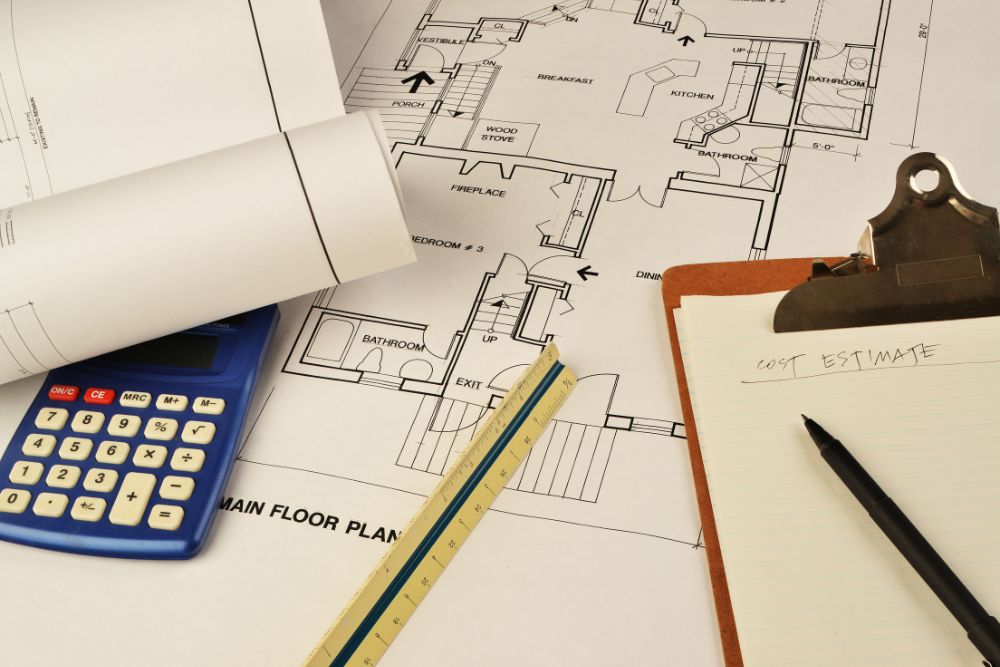In construction, accurate cost estimates are key for budgeting and bidding. They help owners decide if their projects are feasible and how much financing they need. Your approach to estimating and managing the project affects the budget’s accuracy and can show early if the job will satisfy the homeowner and be profitable for you.
According to a survey, about 40% of construction projects exceed their budget due to inaccurate cost estimates.
Estimates can range from rough figures to detailed proposals used for bids and contracts. In this blog, we will discuss the different types of construction estimates, methods of construction estimates, and the costs included in construction estimates.
Types of Construction Estimates
The five major types of building cost estimates are preliminary, detailed, quantity, bid, and control. Each serves a different purpose at different stages of a project’s lifecycle.

Preliminary Estimates
Preliminary estimates are also referred to as Rough or Conceptual estimates; these are early estimates of cost contemplated during the initial phase of a project. These estimates give an initial and general impression of the range of costs that could be involved in a project based on very little detail. Preliminary estimates are useful for assessing project feasibility and obtaining first funding or approval. However, they are less reliable than detailed estimates because the data required at this stage of planning are rather scarce.
Detailed Estimates
Detailed estimates are complete evaluations of all areas of a construction project. These estimates are created once the project’s design and requirements have been finalized. Quantities, unit costs, labor rates, material prices, equipment costs, and other relevant charges are all included in the detailed estimates. This form of the estimate is extremely accurate and is used to budget, plan, and manage project costs throughout the construction process.
Quantity Estimate
Quantity estimates are used to quantify the materials and labor necessary for a building project. This type of estimate is critical when ordering goods and arranging labor. Quantity estimates entail measuring and estimating the quantities of materials, including concrete, steel, lumber, and other building components. Accurate quantity estimates help remove material shortages or excesses, resulting in cost savings and more effective project management.
Bid Estimate
Bids are created by contractors when bidding on construction projects, and the estimates used in bids are also known as bid estimates. These estimates are inclusive of all the necessary costs ranging from wages for employees, cost of materials, equipment, other contractors, admin costs, and desired profit margins. Bids have to be priced correctly, preferably low enough to attract the interest of a client but high enough to be profitable, with the estimates having to be realistic but, at the same time, very competitive. Subcontractors rely on the bid estimates to formulate their pricing strategies and ensure they are profitable.
Cost Estimates
Approximate costs are defined as all the expenses that are incurred in a construction project. These estimates are developed when planning the project, during mid-project analysis, or at the end of the project. These estimates include, but are not limited to, the cost of labor, materials, and equipment and overhead expenses such as permits and insurance. All business processes related to budgeting, financial planning, and controlling expenses concerning a particular project imply the use of cost estimates.
Top Construction Estimation Methods
Different methods are used to estimate construction costs, each with its own strengths and applications. Here are some of the top estimation methods:
Unit Price Estimation
In the unit price estimation a project is divided depending on the different tasks or parts that is to be done and a unit value is provided to each of them. This method is especially used in those projects that contain many replusive activities for instance construction of roads or buildings with many units. Unit prices are calculated from the records, standard rates, and current market rates. This method is convenient when it is necessary to make changes in quantities or scope during the project.
Detailed Estimate
The second method of cost estimation is called detailed or bottom-up estimating, where the cost of each item of the project is estimated approximately. This method needs detailed documentation of the project’s dimensions or characteristics, plan, and the tasks required to be accomplished. Specific estimates provide for labor costs, materials, and equipment costs for the contractor, a subcontractor, and all others. This method is accurate, and it is preferred for large projects with fine details or features incorporated.
Analogous Estimating
Analogous estimating means that estimates are made by comparing the costs of completed similar projects to the cost of a new project. This method is quite effective when there is little or no information available; this is normally the case in the initial stage of a project. The cost estimate of a project can be guessed by comparing the current project with the previous ones involving similar characteristics and conditions. Though not as accurate as represented in detailed estimating, analogous estimating offers a fast and reasonable cost estimation.
Parametric Estimating
Relative to the other methods of cost estimation, parametric estimating is based on statistical analyses and past records of certain parameters that define a project. Such parameters could consist of area, number of units, or time frame of the project. This means that by evaluating the above parameters’ relationship with costs in past projects, estimators can be in a position to formulate a probable cost to be incurred. This method of developing a cost estimate is efficient, and when the parameters of the project are clearly defined, the forecast can be quite accurate.
Three-Point Estimating
Three-point estimating involves calculating three different estimates for each cost element: The analysis of the results may be categorized as optimistic, pessimistic, and most likely. These estimates are then used to result in an average or weighted average cost. This method takes into account probabilities of risks and uncertainties involved in the project and is, hence, more accurate. Three-point estimating is used more effectively in conditions where there is a lot of variability involved or where risks are involved.
What Costs Are Included in Construction Estimates?
The construction estimator must know what costs are involved so that appropriate budgeting can be made. These costs can be categorized into several key areas following:

Labor
Labor costs can be defined as wages, salaries, and other payments in the form of benefits and other expenses that have to be incurred in order to address the manpower component required for a given construction project. This includes direct labor or the workforce inside the construction site and the other categories of employees such as supervisors and project managers. Labor costs are likely to differ for a project depending on the regions of operation, the difficulty of the project, and its timeline.
Materials
Building costs include all the items needed for structures, such as concrete, steel, wood, insulation, and other finishes. It is also necessary to make precise calculations of the required material to prevent the lack of certain materials that can hold the project and, on the contrary, have an excess of supplies that can also add additional expenses to the general cost of the project.
Equipment
Accommodation expenses are necessary expenses that refer to the cost of hiring or purchasing equipment that is required to undertake the project, like excavators, cranes, others, and power tools. These costs also include consumables, fuel, and transport of equipment to and from the location.
Subcontractors
Extras include subcontracting with other trades or firms to provide services that are specialized within the project, such as electrical or plumbing. Such costs may be employed by the subcontractor, such as wages, equipment, and any other materials used for the sub-contract work.
Other
Some tops in construction costs that are factored in estimates are permits, insurance, bonding, and contingencies for administration. These costs help in the regulation standards of the project and may account for other expenses or changes in the scope of the project.
Where Do Estimators Find Cost Data?
Cost data is the foundation for any realistic estimate in construction. Estimators rely on various sources to gather this critical information, including:
Historical Data
One of the best sources for estimators is the historical data of prior projects done by the company or by other competitors. Thus, figuring out cost characteristics for similar projects that were implemented under comparable conditions makes it possible to develop reasonable estimates for a new project.
Supplier Quotes
Pricing from suppliers is one of the most critical documents when it comes to cost estimating. Purchasing managers make quotations with several suppliers and try to find out which of them offers the best price fitting the needs of the project at hand.
Industry Standards
It is important to note that industry standards and guidelines in relation to construction activities establish benchmark costs that are performed. RSMeans and the Construction Specifications Institute (CSI), for example, have databases of many standard costs for estimators to use.
Subcontractor Bids
The bids that the subcontractors give in relation to more specific work on the project make it easier for one to estimate detailed costs for work to be undertaken. Project organizers analyze more than one offer to choose the best and most credible subcontractors.
Market Trends
It is crucial to identify the most suitable and cost-effective building materials as well as appropriate construction technologies because market trends and economic conditions also affect the costs of construction. Such things as changes in the prices of the materials in construction, availability of labor, and even changes in inflation rates are trends that estimators follow to aid them in their estimation procedure.
Online Databases
Online databases and software tools include vast cost data and will help you to get the right estimate. ProEst, PlanSwift, and Bluebeam integrate current pricing, materials cost, and labor rates to boost the reliability of estimates.
FAQs
Q: What is the most accurate type of construction estimate?
Detailed estimates are the most accurate since they account for all project components and provide full cost estimations.
Q: How do preliminary estimates differ from detailed estimates?
Preliminary estimates are initial cost evaluations generated in the early stages of a project, whereas detailed estimates are comprehensive and based on completed project plans and requirements.
Q: What is the advantage of using unit price estimation?
Unit price estimation allows for easy adjustments if there are changes in quantities or scope, making it flexible for projects with repetitive tasks.
Q: Why is historical data important in construction estimating?
Historical data provides insights into cost patterns and helps estimators create accurate estimates based on past project experiences.
Q: How do market trends affect construction estimates?
Market trends influence costs for materials, labor, and equipment. Estimators must monitor these trends to adjust their estimates and avoid budget overruns.
Final Words
In construction, it is crucial to make adequate estimates for a project to ensure the success of the general plan. The special offer at Prime Estimation is that we help you get the best quality estimates to help keep your project costs affordable and well-timed. Contact us now and understand how our experienced construction estimating team can assist you in reaching your project targets.











